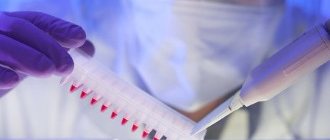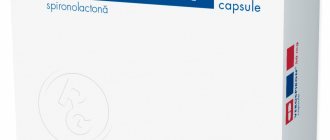Pharmacodynamics and pharmacokinetics
Pharmacodynamics
Telmisartan is a selective angiotensin II . It has a high affinity for AT1 angiotensin II receptors . Competes with angiotensin II at specific receptors, without having the same effect. The binding is long lasting.
Does not have tropism for other receptor subtypes. Reduces the content of aldosterone in the blood, does not suppress renin in plasma and ion channels in cells.
The onset of the hypotensive effect is observed within the first three hours after taking telmisartan . The effect lasts for a day or more. A pronounced effect develops a month after continuous use.
In persons with arterial hypertension , telmisartan reduces systolic and diastolic pressure, but does not change the number of heart contractions.
Does not cause withdrawal syndrome.
Pharmacokinetics
When taken orally, it is quickly absorbed from the intestine. Bioavailability approaches 50%. After three hours, the plasma concentration reaches its maximum. 99.5% of the active substance binds to blood proteins. Metabolized by reaction with glucuronic acid . Metabolites of the drug are inactive. The half-life is more than 20 hours. Excreted through the digestive tract, excretion in urine is less than 2%.
Pharmacokinetics
When taken orally, it is quickly absorbed from the gastrointestinal tract. Bioavailability - 50%. When taken concomitantly with food, the reduction in AUC ranges from 6% (at a dose of 40 mg) to 19% (at a dose of 160 mg). 3 hours after administration, the plasma concentration levels off regardless of taking the drug on an empty stomach or with food. Cmax and AUC are 3 and 2 times higher, respectively, in women compared to men, without a significant effect on concentration. Plasma protein binding is 99.5%, mainly with albumin and alpha1 glycoprotein. The average value of the apparent volume of distribution at the equilibrium stage is 500 l. Metabolized by conjugation with glucuronic acid. Metabolites are pharmacologically inactive. T1/2 - more than 20 hours. Total plasma Cl is high (900 ml/min) compared to hepatic blood flow (about 1500 ml/min). Excreted through the intestines unchanged, excretion by the kidneys is less than 2%.
Side effects
- From the central nervous system: depression , dizziness, headache , fatigue, anxiety, insomnia , convulsions .
- From the respiratory system: diseases of the upper respiratory tract ( sinusitis , pharyngitis , bronchitis ), cough.
- From the circulatory system: marked decrease in pressure , tachycardia , bradycardia , chest pain.
- From the digestive system: nausea, diarrhea , dyspepsia , increased concentration of liver enzymes.
- From the musculoskeletal system: myalgia , lower back pain, arthralgia .
- From the genitourinary system: edema, infections of the genitourinary system, hypercreatininemia .
- Hypersensitivity reactions: skin rash, angioedema , urticaria .
- Laboratory indicators: anemia , hyperkalemia .
- Other: erythema , itching, dyspnea .
Mikardis, instructions for use
According to the instructions for use of Micardis, the drug is taken orally. For adults, the recommended dose is 40 mg once daily. In a number of patients, a therapeutic effect is observed even with a dose of 20 mg per day. If a decrease in pressure to the desired level is not observed, then the dose can be increased to 80 mg per day.
The maximum effect of the drug is achieved five weeks after the start of therapy.
In patients with severe forms of arterial hypertension, 160 mg of the drug per day can be used
Composition and release form
| Pills | 1 table |
| telmisartan | 40 mg |
| excipients: polyvidone; meglumine; sodium hydroxide; sorbitol; magnesium stearate |
7 pcs in blister; There are 2 or 4 blisters in a cardboard box.
| Pills | 1 table |
| telmisartan | 80 mg |
| excipients: polyvidone; meglumine; sodium hydroxide; sorbitol; magnesium stearate |
7 pcs in blister; There are 2 or 4 blisters in a cardboard box.
Interaction
Telmisartan activates the hypotensive effect of other blood pressure lowering drugs.
When telmisartan and digoxin , it is necessary to periodically determine the concentration of digoxin in the blood, as it may increase.
When taking lithium and ACE inhibitors lithium content in the blood may occur , which manifests itself as a toxic effect.
Treatment with non-steroidal anti-inflammatory drugs together with Micardis in dehydrated patients may lead to the development of acute renal failure.
Pharmacological properties of the drug Mikardis
Pharmacodynamics. Telmisartan is a specific and effective angiotensin II receptor antagonist (AT1 type). Telmisartan with a very high degree of affinity replaces angiotensin II at the sites of its binding to AT1 type receptors responsible for the physiological effects of angiotensin II. Telmisartan does not exhibit partial agonist activity against AT1 receptors. Binding to the receptor is specific and long-lasting. Telmisartan has no affinity for other receptors, including AT2 and other AT receptors. The functional role of these receptors is not known, nor has the effect of their possible overstimulation by angiotensin II, the level of which increases under the influence of telmisartan, been identified. Telmisartan reduces the level of aldosterone in the blood plasma, does not affect the activity of renin in the blood plasma, does not block ion channels, and does not have an inhibitory effect on ACE (kininase II), an enzyme that also destroys bradykinin. Therefore, the use of the drug is not accompanied by side effects associated with the accumulation of bradykinin. When taken at a dose of 80 mg, telmisartan almost completely blocks the hypertensive effect of angiotensin II, the pronounced antihypertensive effect persists for 24 hours and remains significant up to 48 hours. After taking the first dose of telmisartan, the antihypertensive effect develops gradually over 3 hours, the maximum hypotensive effect develops after 4–8 weeks after the start of treatment and persists with long-term use of the drug. The antihypertensive effect remains at a constant level for 24 hours after administration, including the last 4 hours before the next dose. This was confirmed by ambulatory blood pressure monitoring. In patients with hypertension (arterial hypertension), telmisartan reduces both systolic and diastolic blood pressure without affecting heart rate. If the drug is suddenly discontinued, the blood pressure level gradually returns to its original level without the development of withdrawal syndrome. Clinical studies have confirmed that treatment with telmisartan significantly reduces left ventricular myocardial mass and left ventricular myocardial mass index in patients with hypertension (arterial hypertension) and left ventricular myocardial hypertrophy. Clinical studies have shown that telmisartan is significantly less likely than ACE inhibitors to cause the development of a dry cough. Pharmacokinetics. Rapidly absorbed after oral administration, average absolute bioavailability is about 50%. If the drug is taken with food, the decrease in AUC varies from 6% (when taken at a dose of 40 mg) to 19% (when taken at a dose of 160 mg). 3 hours after taking the drug, the concentration in the blood plasma stabilizes and does not depend on whether telmisartan was taken on an empty stomach or with food. Telmisartan is highly bound to plasma proteins (99.5%), mainly to albumin and alpha-1-acid glycoprotein. The volume of distribution at equilibrium is about 500 l. Telmisartan is metabolized by conjugation with a glucuronide. The conjugate has no pharmacological activity. Telmisartan is characterized by a biexponential pharmacokinetic profile with a terminal half-life of more than 20 hours. The maximum plasma concentration and AUC increase disproportionately to the dose. There is no data on clinically significant accumulation in the body when used in recommended doses. Plasma concentrations are higher in women than in men, without changing effectiveness. After oral administration, telmisartan is almost completely excreted in the feces, usually unchanged, with urinary excretion accounting for less than 2% of the dose. The total plasma clearance is high (about 900 ml/min) when compared with the hepatic blood flow (about 1500 ml/min). Special categories of patients Elderly patients The pharmacokinetics of telmisartan in elderly patients does not differ from that in younger patients. Patients with impaired renal function In patients with renal failure on dialysis, lower plasma concentrations of telmisartan are noted, but this is not clinically significant. Telmisartan has a high degree of binding to plasma proteins, so it is practically not excreted during dialysis. Patients with impaired liver function In patients with impaired liver function, bioavailability increases to 100%.
special instructions
For dehydrated patients (restriction of salt intake, treatment with diuretics , diarrhea , vomiting), a reduction in the dose of Micardis is necessary.
Prescribe with caution to persons with stenosis of both renal arteries , stenosis of the mitral valve or aorta, obstructive hypertrophic cardiomyopathy , severe renal, hepatic or heart failure, diseases of the digestive tract.
It is prohibited to use in case of primary aldosteronism and fructose intolerance .
If you are planning a pregnancy, you must find in advance a replacement for Micardis with another antihypertensive drug .
Use with caution when driving vehicles.
When taken simultaneously with lithium , monitoring of lithium levels in the blood is indicated, as a temporary increase in its level is possible.
Interactions of the drug Micardis
Telmisartan may potentiate the hypotensive effect of other antihypertensive agents. Compounds that were studied in pharmacokinetic studies: digoxin, warfarin, hydrochlorothiazide, glibenclamide, ibuprofen, paracetamol, simvastatin and amlodipine. Only for digoxin, a 20% (in some cases 39%) increase in its concentration in the blood plasma relative to the average level is noted, so the need to monitor the level of digoxin in the blood plasma should be taken into account. When used simultaneously with lithium salts, it is possible to increase the concentration of lithium in the blood plasma and develop toxic reactions, therefore it is necessary to regularly monitor the level of lithium in the blood plasma. NSAID therapy (including acetylsalicylic acid in doses exceeding 0.3 g per day and COX-2 inhibitors) can lead to the development of acute renal failure in dehydrated patients. Compounds that affect the renin-angiotensin system, such as telmisartan, have a synergistic effect. When initiating combination therapy with NSAIDs and Micardis, patients should be provided with adequate hydration and close monitoring of renal function. During concomitant therapy with NSAIDs, a decreased effect of antihypertensive agents such as telmisartan has been reported due to inhibition of the vasodilatory effect of prostaglandins.
Micardis analogs
Level 4 ATC code matches:
Telmisartan
Irbesartan
Presartan
Nortivan
Candesartan
Kozaar
Aprovel
Teveten
Blocktran
Cardosal
Valsartan
Losartan
Atakand
Diovan
Valsacor
Vazar
Valz
Lorista
Lorista
Lozap
The most accessible analogues of Mikardis are: Praytor , Telmista , Hipotel .
Mikardis price
In Russia, a package of the drug 80 mg No. 28 will cost from 830 to 980 rubles. In Ukraine, the price of Mikardis in the same release form is close to 411 hryvnia.
- Online pharmacies in RussiaRussia
- Online pharmacies in UkraineUkraine
- Online pharmacies in KazakhstanKazakhstan
ZdravCity
- Mikardis tablets 40 mg 28 pcs. Boehringer Ingelheim Ellas AE
RUB 1,064 order - Mikardis Plus tablets 80mg+12.5mg 28pcs Boehringer Ingelheim
RUB 1,065 order
- Micardis tablets 80 mg 28 pcs. Boehringer Ingelheim Ellas AE
RUB 1,061 order
Pharmacy Dialogue
- Mikardis tablets 40 mg No. 28 Boehringer Ingelheim
1101 rub. order
- Mikardis plus (tab. 80 mg/12.5 mg No. 28)Boehringer Ingelheim
1112 rub. order
- Micardis tablets 80 mg No. 28 Boehringer Ingelheim
1100 rub. order
- Mikardis plus tablets 80mg/12.5mg No. 28Boehringer Ingelheim
1102 rub. order
show more
Pharmacy24
- Mikardis plus 80 mg N28 tablets Boehringer Ingelheim Pharma GmbH & Co. KG/Boehringer Ingelheim Ellas A.E., Nimechina/Greece
807 UAH.order - Mikardis 80 mg N28 tablets Boehringer Ingelheim Pharma GmbH & Co. KG/Boehringer Ingelheim Ellas A.E., Nimecchina/Greece
749 UAH. order
PaniPharmacy
- Micardis tablets Micardis tablets. 80 mg No. 28 Germany, Boehringer Ingelheim Pharma
812 UAH order
show more


